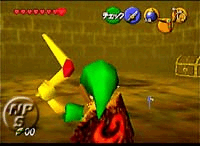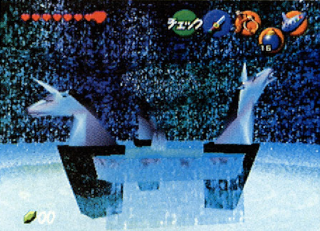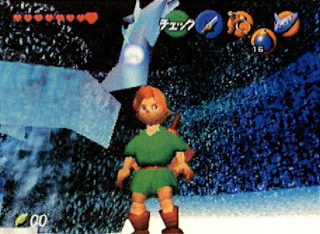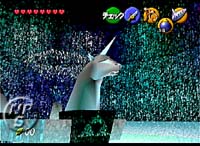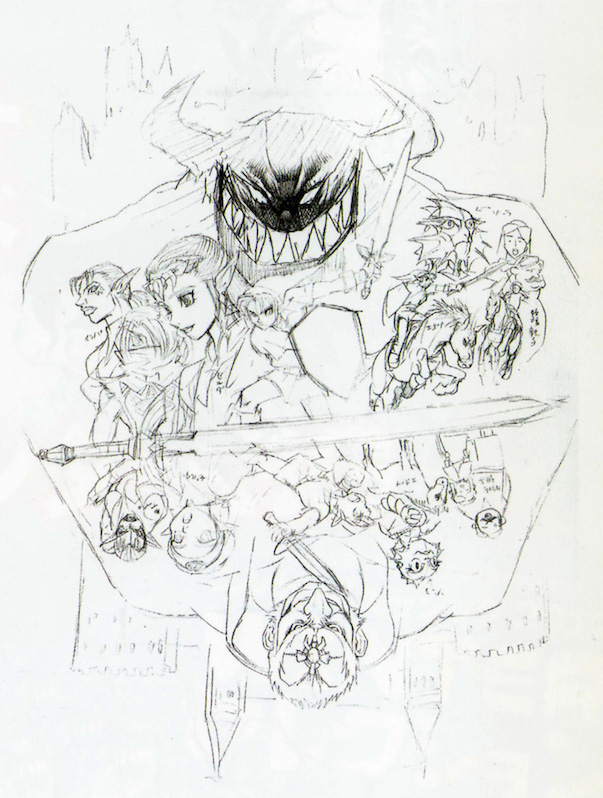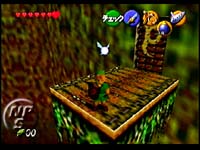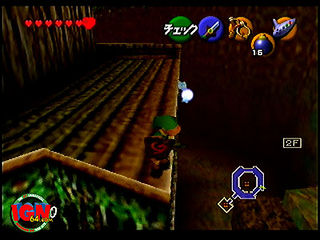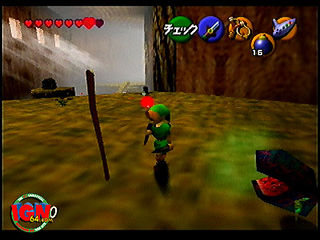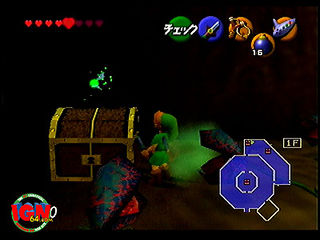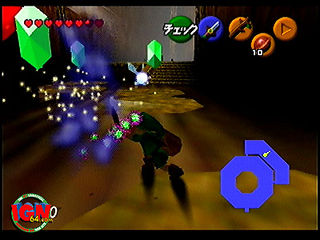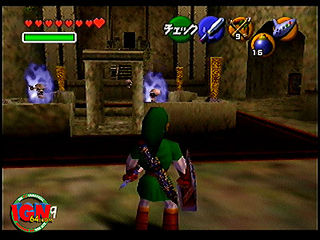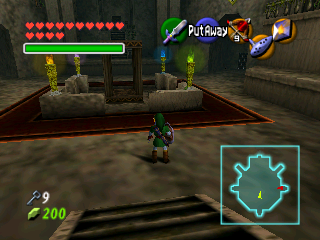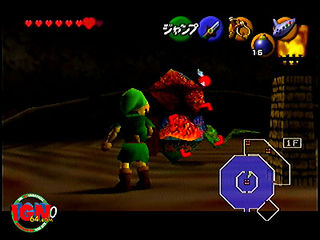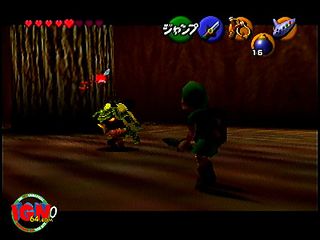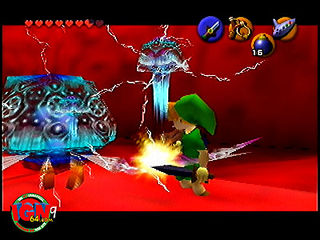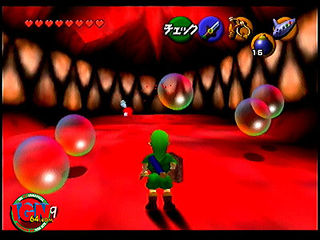Prerelease:The Legend of Zelda: Ocarina of Time/Sword on A (Part 2)
This is a sub-page of Prerelease:The Legend of Zelda: Ocarina of Time.
Contents
February 1998
Items
Boomerang
The boomerang is shown off in the room above King Dodongo's Lair, functioning like it does in the final. The icon for the boomerang is redder than in the final, and can be seen in greater detail in the Spaceworld 1997 overdump. Weirdly, while screenshots of Jabu-Jabu's Belly came out in March 1998 alongside these boomerang pictures, none of those Jabu-Jabu screenshots show the boomerang being used.
Revisited - Death Mountain
| Prototype | Final |
|---|---|
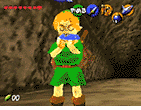 |
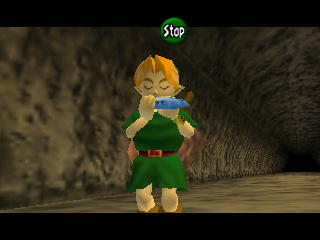 |
xxx
Revisited - Dodongo's Cavern
| Feb. 1998 | Concept Art | Final |
|---|---|---|
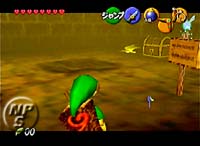 |
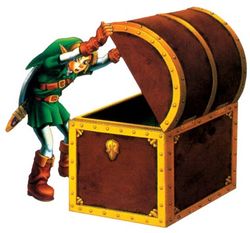 |
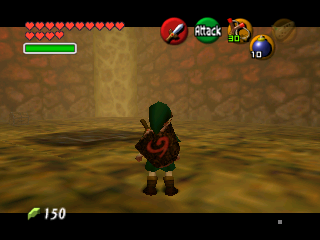
|
Instead of the small, brown, bomb-filled chest of the final game, the cavern's pre-boss room contains a large gold chest and a sign. Its walls are covered with the brown brick texture seen in one of the initial screenshots of the cavern exterior.
The gold chest's design is identical to the treasure chests in Link's Awakening and the small treasure chests in A Link to the Past. It ultimately went unused in Zelda 64, but was reused for both small and large treasure chests in Majora's Mask.
Back Alley
| Prototype | Final |
|---|---|
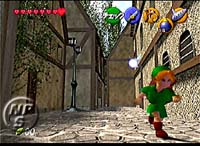 |
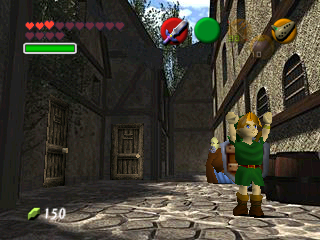 |
Like the entrance to Hyrule Castle Town, this section of the Back Alley has a lamppost. There are no barrels on the right.
The old man dressed in robes is nowhere to be seen.
The door to the dog lady's house is missing. At this time, the dog lady's house was still a home in Kakariko Village.
| Prototype | Final |
|---|---|
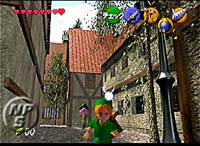 |
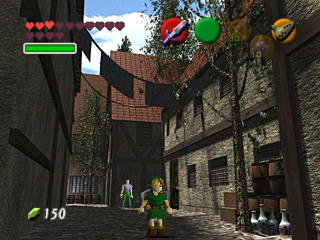 |
Instead of barrels, bottles, and boxes, a lamppost stands beside the tree. Laundry lines hang from the windows overhead.
A second door in the Back Alley is also missing. In the final game, it can only be entered at night, and leads to a house with a man who tells Link that he thinks it's weird that strange packs of dogs roam the streets of the city at night. Like the dog lady's house, it was originally a home in Kakariko Village.
The man standing in the alley is normally found outside of the Bazaar in Hyrule Castle Town Market.
Unicorn Fountain
| Late 1997 Overdump | February 1998 | Healing Fairy Fountain | Great Fairy Fountain |
|---|---|---|---|

|
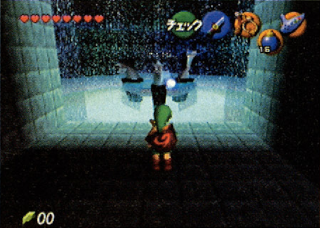
|
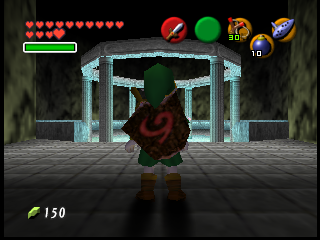
|
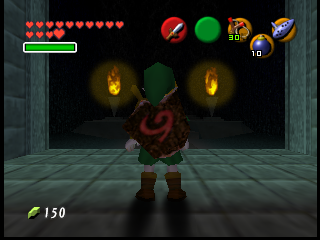
|
| Late 1997 Overdump | February 1998 | Healing Fairy Fountain | Great Fairy Fountain |
|---|---|---|---|
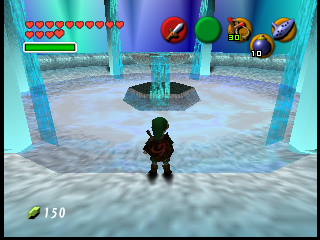
|
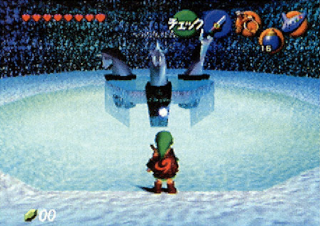
|
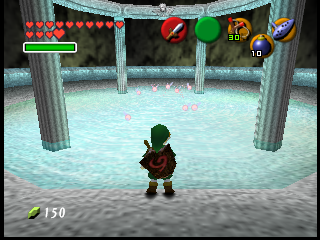
|
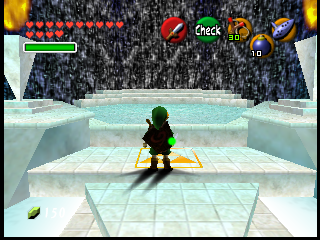
|
This fountain map which started with just a fountain in the middle of it and later featured distinctive unicorns was remodeled for the final game. In this point in development the fountains with Great Fairies weren't created yet, and when they were created, certain design elements were split between these healing type fountains and the ones with Great Fairies. Majora's Mask's fountain design has the look of the healing fountains, but with the sparkly BG effect from Great Fairy Fountains as those aren't located underground. These screenshots when the game was new (and no leaks existed) prompted fans to search high and low for this mythical Unicorn Fountain, believing its location to be a well-hidden secret - and also believing it contained the Triforce.
March 1998
Child Link's Model
| February 1998 | March 1998 |
|---|---|
Child Link's model was updated and it's now using a new skeleton type. The model is identical to final aside from lighter green tunic color. This page has an in-depth write-up on what the skeleton change meant.
Interface
Child Link
| Nov.’97 | Mar.’98 |
|---|---|
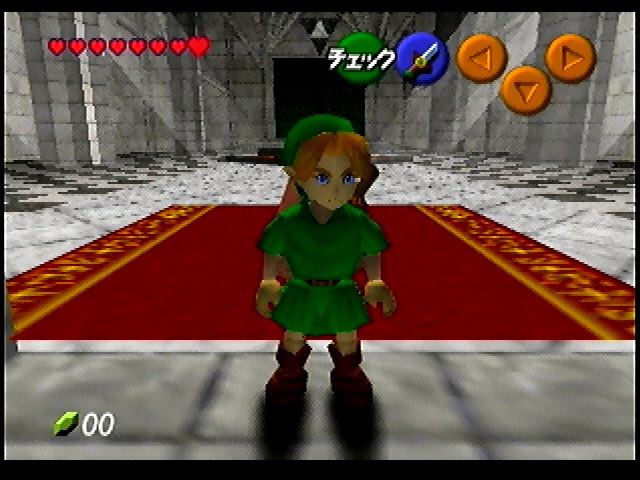 |
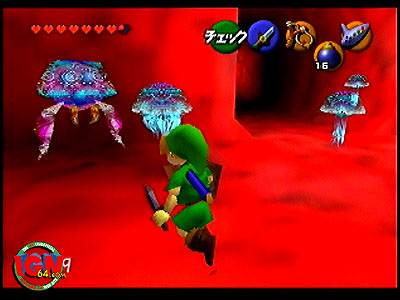 |
| GUI | The GUI is identical to Adult Link's. |
| A Button | Child Link's sword is equipped to A. |
| B Button | B still serves as the action button. When Link stands next to an NPC, it reads “しゃべる” (Speak). When standing in front of a sign, it reads "みる" (Look). When a text box appears, it reads "つぎへ" (Next). When standing near a Bomb Flower, it reads "つかむ" (Grab). When holding a bomb, it reads "なげる" (Throw). When Z-targeting, it reads "ジャンプ" (Jump). When hanging off a ledge, it reads "おりる" (Get Down). It now seems to default to "チェック" (Check), though it occasionally reads "ナビィ" (Navi). |
| C-Left | Child Link is shown with a variety of items equipped to C-Left, including nothing, 16 bombs, the Boomerang, and Deku Sticks. |
| C-Right | Child Link is shown with a variety of items equipped to C-Right, including nothing, 16 Deku Nuts, and the Slingshot. |
| C-Down | Child Link is shown with a variety of items equipped to C-Down, including nothing, Deku Sticks, and 10 Deku Nuts. |
| Hearts | Child Link has a variable number of hearts, but the total is always 8. |
| Rupees | Child Link has 0 to 6 rupees, and the rupee counter is two digits. |
| Magic Meter | No magic meter is visible. |
Specifications
Long after its title was officially announced in Dec. 1997, Nintendo Power belatedly reported that the tentative sub-title for Zelda 64 was Ocarina of Time.[1]
Logo
| A Link to the Past | Mar. 1998 Logo | Final Logo |
|---|---|---|
 |
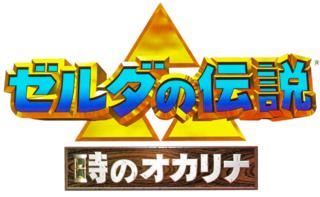 |
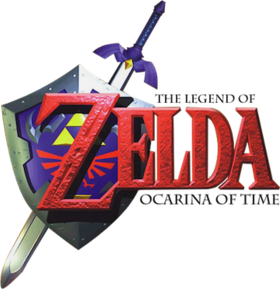
|
A logo for Ocarina of Time, similar to the Japanese logo for A Link to the Past, was featured in this month's issue of Famimaga 64.[2] It is unclear whether this was an early logo released by Nintendo or simply a magazine mockup. The final version of the Japanese game used the English logo seen above.
Release Date
An official release date had yet to be announced for the game, but Nintendo chairman Howard Lincoln said that it would definitely be out sometime in the second half of 1998.[1] Nintendo Power's Release Forecast slotted the game into "Fall ’98".[1]
Gold Cartridge
Nintendo Power also reported that the game cartridge would be gold, like The Legend of Zelda for the NES.[1] In the end, however, only players who preordered the game received a gold cartridge, while regular cartridges were grey.
Story
The magazine described the Ocarina of Time as a magical instrument and stated that the price for getting the ocarina was finding three Spiritual Stones on Link's journey.[1]
Sort
Link seems to be able to do just about everything, from throwing a boomerang to reading road signs to Mt. Goron.[1]
Concept Art
- Final Master Sword design. (Shown well in April. Introduced when?)
- Final Sheik design. (Introduced in April.)
- Final Adult Zelda design. (Introduced when?)
- Final Child Zelda design. (Introduced in Nov.)
- Final Impa design. (Introduced when?)
- Non-final Ganon design.
- Non-final Zora design.
- Non-final Talon design.
- Non-final Malon design.
- Near-final Hyrule Castle design. Missing a tower, could be the artist’s fault. (Introduced in March.)
Environments
Revisited - Inside the Deku Tree
These screenshots of the Deku Tree appear to match the Deku Tree map found in The Spaceworld 97 overdump, which is of a much different design than the final game. This first screenshot appears to show Link standing on a broken bridge in the central chamber, next to a door leading away from the tower.
This shows Link standing on one of the paths winding around the tower in the central chamber. It also features an old style of minimap, which showed the dungeon map a floor at a time (instead of a room at a time in the final), and used dynamically-generated color palettes to highlight the room you were currently in. (You can see the entire minimap for this dungeon in the SW97 overdump.)
This picture shows Link in one of the rooms going around the central chamber. This room features a series of platforms that must be crossed to reach a ledge on the other side (which Link has reached in this picture). There's also a set of stairs to get back to the start of the platforming section, which can just barely be seen just above Navi (who's colored red instead of yellow to indicate enemies).
Based on the minimap, this shows Link in the corner of that same ledge he's standing on in the previous screenshot.
Link defeating a Tailpasaran in the room with light shining through the windows. More actors were added to this room since the Overdump map as the Tailpasaran aren't included in this room in that version.
Jabu Jabu's Belly
| Prototype | Final |
|---|---|
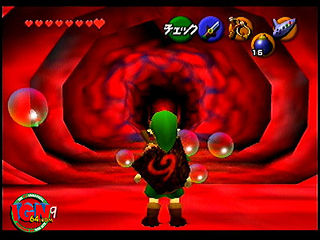 |
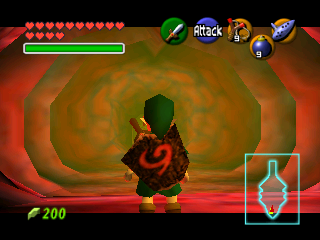 |
Jabu-Jabu didn't have the green fog effect at this stage of development. The red textures also appear to be more saturated, though this might just be a result of the pre-release images' quality. The mouth textures appear the same here otherwise, and (as shown in the remaining screenshots) might be one of the few places the old texture choice has survived in the final game.
| Prototype | Final |
|---|---|
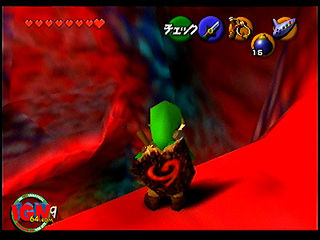 |
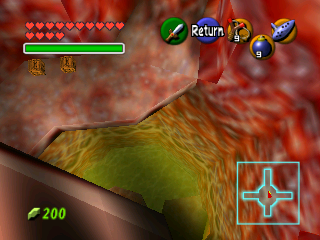 |
This room with ledges around what appears to be an open pit seems to match with the circular central room of the final dungeon. The ledges are wider and flatter in the final version of the game, and the room makes use of a somewhat more colorful pink texture in the final game (which can be seen in all the other comparisons as well).
| Prototype | Final |
|---|---|
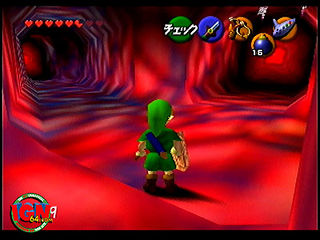 |
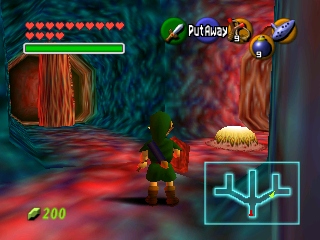 |
This set of hallways used to feature an eye-gouging red texture for the walls, but was swapped for a mainly teal look in the final. The blocking tentacles aren't seen here, but may just be out of shot.
| Prototype | Final |
|---|---|
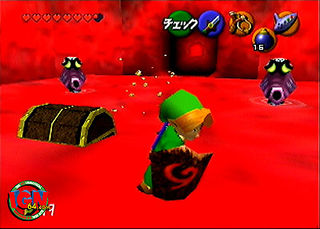 |
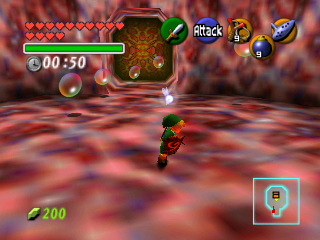 |
This room with Octoroks might match the room with Shaboms in the final. If so, it seems that aside from the enemy difference, this room used to not be a timed challenge to kill all the enemies, giving access to the chest right away.
| Prototype | Final |
|---|---|
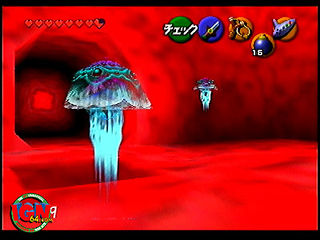 |
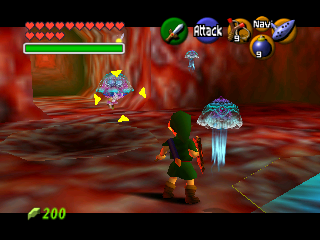 |
This picture seems to show the room where you first meet Ruto. The dark texture on the ground indicates that the holes to the lower level used to be square, rather than the final's circular pitfalls. The texture of Jabu-Jabu's insides are shown to have changed here too.
Forest Temple
| Prototype | Final |
|---|---|
The elevator in the main chamber of the Forest Temple sits above the ground, despite none of the torches being lit. Oddly enough, there are also three Blue Bubble enemies flying around.
Enemies
Revisited - Deku Baba
Deku Babas having their finalized design. Previous design had different texturing work for the head, which had a more brown appearance compared to final's purple-ish one.
Mad Scrub
Mad Scrubs at first used to look identical to the Deku Scrubs. Deku Scrubs weren't added till 1998-08-06 according to the commit logs. They were given a makeover so they could be distinguished from the Deku Scrubs who give you hints.
Tailpasaran
| Prototype | Final |
|---|---|
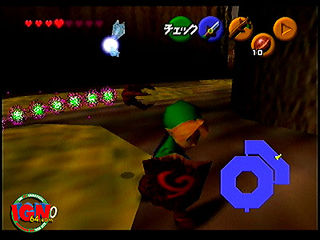 |
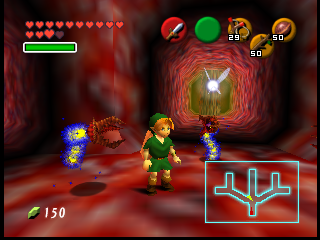 |
The "sparkling tail" of Tailpasarans used to be green instead of purple.
Revisited - Octorok
First screenshots where we saw Octorok's new updated design. According to the commit logs it was changed from the Octorok which looked closer to the older Zelda games on 1998-01-19.
Biri
xxx
Bubble
xxx
References
Index
| Introduction | Conception - December 1995 |
|---|---|
| A + B | October 1996 - April 1997 |
| A + C | May - July 1997 |
| Early Sword on A | August - September 1997 |
| Sword on A | October - December 1997 • January - March 1998 • April 1998 • May - June 1998 • July - August 1998 |
| Sword on B | August - September 1998 • October - November 1998 |
